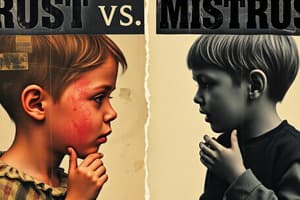Podcast
Questions and Answers
What is the primary focus of Primary Prevention in the healthcare system?
What is the primary focus of Primary Prevention in the healthcare system?
- Palliative Care
- Health Promotion and Illness Prevention (correct)
- Diagnosis and Treatment
- Rehabilitation and Health Restoration
Which screenings fall under the category of Secondary Prevention in the healthcare system?
Which screenings fall under the category of Secondary Prevention in the healthcare system?
- Vision and hearing tests
- Smoking cessation campaigns
- Cholesterol level testing (correct)
- Immunizations
What is the main goal of Tertiary Prevention in the healthcare system?
What is the main goal of Tertiary Prevention in the healthcare system?
- Early detection and intervention
- Prevention before illness occurs
- Regaining previous level of health or optimal function (correct)
- Encouraging healthy behaviors
Which level of care involves early detection and intervention to manage or control diseases at their early stages?
Which level of care involves early detection and intervention to manage or control diseases at their early stages?
What is the key focus of Disease Prevention in the healthcare system?
What is the key focus of Disease Prevention in the healthcare system?
Which of the following is NOT a part of Primary Prevention in the healthcare system?
Which of the following is NOT a part of Primary Prevention in the healthcare system?
What is clubfoot characterized by?
What is clubfoot characterized by?
What does footdrop refer to?
What does footdrop refer to?
What is pigeon toes characterized by?
What is pigeon toes characterized by?
What is the primary task during the preschool stage according to Erikson's developmental theory?
What is the primary task during the preschool stage according to Erikson's developmental theory?
What is Trochanter Roll used for?
What is Trochanter Roll used for?
What are hand rolls used for?
What are hand rolls used for?
How should parents respond to preschoolers who show negativism (persistent 'no' for an answer)?
How should parents respond to preschoolers who show negativism (persistent 'no' for an answer)?
What is the key difference between Initiative and Industry during the preschool to school age transition?
What is the key difference between Initiative and Industry during the preschool to school age transition?
Why is it important not to correct preschoolers during their Initiative stage according to Erikson's theory?
Why is it important not to correct preschoolers during their Initiative stage according to Erikson's theory?
What type of activities are typically associated with the preschool vs. school age stages according to Erikson's theory?
What type of activities are typically associated with the preschool vs. school age stages according to Erikson's theory?
What is the common characteristic of preschoolers displaying ritualism according to Erikson's theory?
What is the common characteristic of preschoolers displaying ritualism according to Erikson's theory?
Flashcards are hidden until you start studying
Study Notes
Erikson's Developmental Theory
- Individuals pass through 8 stages of psychosocial development, each with a unique conflict or crisis to be resolved for healthy development.
- Failure to resolve these conflicts can lead to negative outcomes later in life.
Infant (0-1 year)
- Primary task is to develop trust in caregivers and the world.
- Consistent caregiving helps infants feel safe and secure, leading to trust.
- Failure to establish trust can lead to feelings of insecurity and mistrust.
Toddler (1-3 years)
- Developing a sense of independence vs. shame and doubt.
- Characteristics:
- Negativism (persistent "no" answers)
- Tantrums (ignore them, use time-outs, and praise good behavior)
- Ritualism (bedtime rituals)
- Overly restrictive or critical parenting can lead to shame and doubt.
Preschool (3-5 years)
- Initiatives: learning to do things without correction.
- Ritualism and imitation are prominent.
School Age (6-12 years)
- Industry: learning to do things well and achieving mastery or perfection.
Adolescent (13-19 years)
- Developing a coherent sense of self and identity vs. confusion.
- Achievement: forming a clear and stable sense of identity, including personal values and life goals.
- Fear of rejection or inability to form close relationships can lead to feelings of isolation and loneliness.
Health Care Delivery System
- The U.S. healthcare system has 5 levels of care:
- Disease prevention
- Health promotion
- Primary, secondary, and tertiary health care
Primary Prevention
- Focuses on promoting health and preventing illness before it occurs.
- Examples: smoking cessation campaigns, immunizations, healthy lifestyle education, and regular physical activity programs.
Secondary Prevention
- Involves early detection and intervention to manage or control diseases at their early stages.
- Examples: cancer screenings, cholesterol level testing, diabetes screenings, vision and hearing tests, and mental health screenings.
Tertiary Prevention
- Aims to help individuals regain their previous level of health or achieve the highest level of function possible.
- Examples: rehabilitation, health restoration, and palliative care.
Deformities
- Clubfoot: inward or outward deviation of the foot, making it difficult to place the sole flat on the ground.
- Footdrop: weakness or paralysis of the muscles controlling dorsiflexion, leading to dragging the foot.
- Pigeon Toes: inward rotation of the feet and toes when walking or standing.
Positioning and Equipment
- Trochanter Roll: used to prevent external rotation of the hips when a patient is lying in a supine position.
- Hand Rolls: used to maintain the thumb in a slight adduction and in opposition to the fingers, ensuring a functional hand position.
Studying That Suits You
Use AI to generate personalized quizzes and flashcards to suit your learning preferences.




